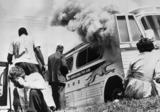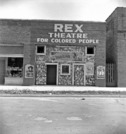
Students will create a compilation of 20 images from the 1960s and explain the significance of each image.
- Subject:
- History
- Material Type:
- Activity/Lab
- Assessment
- Diagram/Illustration
- Date Added:
- 07/14/2017

Students will create a compilation of 20 images from the 1960s and explain the significance of each image.

In which John Green teaches you about a time of relative tumult in the United States, the 1960s. America was changing rapidly in the 1960s, and rights movements were at the forefront of those changes. Civil Rights were dominant, but the 60s also saw growth in the Women's Movement, the LGBT Rights Movement, the Latino Rights Movement, and the American Indian Movement. Also, Americans began to pay a bit more attention to the environment. All this change happened against the backdrop of the Cold War and the Rise of Conservatism. It was just wild. John will teach you about sit-ins, Freedom Rides, The March on Washington, MLK, JFK, LBJ, and NOW. Man, that is a lot of initialisms. And one acronym.
Chapters:
Introduction: The 1960s
The Civil Rights Movement
Martin Luther King, Jr.
JFK and the Civil Rights Movement
LBJ, the Civil Rights Act, and the Great Society
Inequality in Urban America
Malcolm X, Black Power, and the Black Panther Party
Student Activism and Other Civil Rights Movements of the 1960s
Mystery Document
The Environmental Movement
The American Feminist Movement
The Supreme Court During the Warren Era
1968 was kind of a big year
Credits

OYH Multimedia Anthologies anthologies collect a range of materials for exploring OYH topics. They parallel and supplement the OYHL school modules, available as Open Education Resources. . Groups of all ages can explore & discuss these rich and varied collections for sharing reflections on aspects of U.S. history and deepening historical knowledge. They are also available through the OYH website, https://www.ownyourhistory.us/multimediaresourcesIn US history, land ownership provides family security and cohesion, wealth accumulation, and social advancement. American law supports these goals for most Americans, but often not for Black Americans or other communities of color. The 1960s Civil Rights Movement led to some positive changes, but inequality continues. This module primarily examines housing and financing discrimination affecting urban Black families, in urban areas, it briefly considers rural Black property ownership.The resource focuses on housing and real property ownership because of the important role of a home as a basis for economic security, wealth creation, family relationships and stability.

In US history, land ownership provides family security and cohesion, wealth accumulation, and social advancement. The American law supports these goals for most Americans, but often not for Black Americans or other communities of color. The 1960s Civil Rights Movement led to some positive changes, but inequality continues. This module primarily examines housing and financing discrimination affecting urban Black families, in urban areas, it briefly considers rural Black property ownership.The module focuses on housing and real property ownership because of the important role of a home as a basis for economic security, wealth creation, family relationships and stability. The country has a substantial social investment in existing housing and the color-based housing patterns that still result in significant segregation in most cities. It asks how to move toward a legal system, housing policies and practices of genuine equality, opportunity, and freedom for all without separation by color in our cities and communities. While not addressing reparations for inequalities from enslavement and segregation, it asks students to develop proposals addressing such inequalities.

Este video en espanol cubre el asesinato del Presidente John F. Kennedy y las primeras iniciativas del Presidente Lyndon B. Johnson. Include los apuntes para que los alumnos completen al ver el video.This video in spanish covers the assassination of John F. Kennedy and the first initiatives of President Lyndon B. Johnson. It includes a fill-in-the-blanks document with notes for students to complete as they watch the video.

This clip includes an archival audio clip of President Lyndon B. Johnson's 1965 speech on immigration policy.

Students will research and cite evidence in answering questions regarding the general nature of the Vietnam War.